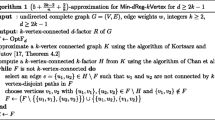Abstract
We give a constant factor approximation algorithm for the Asymmetric Traveling Salesman Problem on shortest path metrics of directed graphs with two different edge weights. For the case of unit edge weights, the first constant factor approximation was given recently by Svensson. This was accomplished by introducing an easier problem called Local-Connectivity ATSP and showing that a good solution to this problem can be used to obtain a constant factor approximation for ATSP. In this paper, we solve Local-Connectivity ATSP for two different edge weights. The solution is based on a flow decomposition theorem for solutions of the Held–Karp relaxation, which may be of independent interest.


Similar content being viewed by others
Notes
An estimation algorithm is a polynomial-time algorithm for approximating/estimating the optimal value without necessarily finding a solution to the problem.
For ATSP, we can think of a node-weighted graph as an edge-weighted graph where the weight of an edge (u, v) equals the node weight of u.
That is, the maximum flow value from s to any proper subset \(T'\subsetneq T\) is smaller than \(c(\delta ^+(s))\).
Note that \(s \notin A\) since \(D_f\) contains a path from \(t_k\) to s.
Note that we decompose the vertex set \(V_i\), but with respect to the edge set \(E(G_i^{\mathrm {aux}})\), not \(E(G[V_i])\).
To obtain exactly 1 / 2, we might need to break an edge up into two copies, dividing its \(x^\star _{\mathrm {sp}}\)-value between them appropriately, and include one copy in \(X_i^-\) but not the other; we omit this for simplicity of notation, and assume there is such an edge set with exactly \(x^\star _{\mathrm {sp}}(X_i^-)= 1/2\).
Again, we might need to split some edges into two copies.
It is violated unless \(u_i = v_i\).
Note that this walk may exit \(U_i\), but it will stay inside \(V_i\).
Map the path given by Fact 3.11 from \(G_{\mathrm {sp}}\) to G.
References
Anari, N., Oveis Gharan, S.: Effective-resistance-reducing flows and asymmetric TSP. In: Proceedings of the 56th Annual IEEE Symposium on Foundations of Computer Science (FOCS). IEEE (2015)
Arora, S., Grigni, M., Karger, D.R., Klein, P.N., Woloszyn, A.: A polynomial-time approximation scheme for weighted planar graph TSP. In: Proceedings of the Ninth Annual ACM-SIAM Symposium on Discrete Algorithms, SODA 1998, pp. 33–41 (1998)
Asadpour, A., Goemans, M.X., Madry, A., Oveis Gharan, S., Saberi, A.: An O(log n/ log log n)-approximation algorithm for the asymmetric traveling salesman problem. In: Proceedings of the Twenty-First Annual ACM-SIAM Symposium on Discrete Algorithms, SODA 2010, pp. 379–389 (2010)
Berman, P., Karpinski, M.: 8/7-approximation algorithm for (1, 2)-TSP. In: Proceedings of the Seventeenth Annual ACM-SIAM Symposium on Discrete Algorithms, SODA, pp. 641–648 (2006)
Bläser, M.: A 3/4-approximation algorithm for maximum ATSP with weights zero and one. In: Approximation, Randomization, and Combinatorial Optimization, Algorithms and Techniques, 7th International Workshop on Approximation Algorithms for Combinatorial Optimization Problems, APPROX, pp. 61–71 (2004)
Christofides, N..: Worst-case analysis of a new heuristic for the travelling salesman problem. Technical report, DTIC Document (1976)
Erickson, J., Sidiropoulos, A.: A near-optimal approximation algorithm for asymmetric TSP on embedded graphs. In: 30th Annual Symposium on Computational Geometry (SOCG), pp. 130 (2014)
Frieze, A.M., Galbiati, G., Maffioli, F.: On the worst-case performance of some algorithms for the asymmetric traveling salesman problem. Networks 12(1), 23–39 (1982)
Oveis Gharan, S., Saberi, A.: The asymmetric traveling salesman problem on graphs with bounded genus. In: Proceedings of the twenty-second annual ACM-SIAM symposium on Discrete Algorithms, pp. 967–975. SIAM (2011)
Oveis Gharan, S., Saberi, A., Singh, M.: A randomized rounding approach to the traveling salesman problem. In: IEEE 52nd Annual Symposium on Foundations of Computer Science, FOCS 2011, pp. 550–559 (2011)
Grigni, M., Koutsoupias, E., Papadimitriou, C.H.: An approximation scheme for planar graph TSP. In: 36th Annual Symposium on Foundations of Computer Science, FOCS 1995, pp. 640–645 (1995)
Karpinski, M., Lampis, M., Schmied, R.: New inapproximability bounds for TSP. J. Comput. Syst. Sci. 81(8), 1665–1677 (2015)
Mömke, T., Svensson, O.: Approximating graphic TSP by matchings. In: IEEE 52nd Annual Symposium on Foundations of Computer Science, FOCS 2011, pp. 560–569 (2011)
Mucha, M.: 13/9-approximation for graphic TSP. In: 29th International Symposium on Theoretical Aspects of Computer Science, STACS 2012, pp. 30–41 (2012)
Papadimitriou, C.H., Yannakakis, M.: The traveling salesman problem with distances one and two. Math. Oper. Res. 18(1), 1–11 (1993)
Sebő, A., Vygen, J.: Shorter tours by nicer ears: 7/5-approximation for the graph-TSP, 3/2 for the path version, and 4/3 for two-edge-connected subgraphs. Combinatorica 34(5), 597–629 (2014)
Svensson, O.: Approximating ATSP by relaxing connectivity. In: Proceedings of the 56th Annual IEEE Symposium on Foundations of Computer Science (FOCS) (2015)
Williamson, D.P., Shmoys, D.B.: The Design of Approximation Algorithms. Cambridge University Press, Cambridge (2011)
Author information
Authors and Affiliations
Corresponding author
Additional information
O. Svensson and J. Tarnawski: supported by ERC Starting Grant 335288-OptApprox; László A. Végh: supported by EPSRC First Grant EP/M02797X/1.
Rights and permissions
About this article
Cite this article
Svensson, O., Tarnawski, J. & Végh, L.A. Constant factor approximation for ATSP with two edge weights. Math. Program. 172, 371–397 (2018). https://doi.org/10.1007/s10107-017-1195-7
Received:
Accepted:
Published:
Issue Date:
DOI: https://doi.org/10.1007/s10107-017-1195-7




